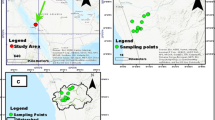Abstract
Adverse effect of rapid industrialization on groundwater quality and quantity is widely known problem especially in develo** countries. Tirupur, which is situated on the bank of Noyyal River in India, is known for intensive textile processing activities. As groundwater is the main water source for drinking water, there is an urgency to assess the groundwater quality. Twenty groundwater samples were collected for each post and pre-monsoon sampling during August 2009 and March 2010, respectively. Chemical and statistical analysis along with numerical modelling has been performed to assess the current status. The hydro-geochemical study revealed that the dominance of Mg–Cl and Na–HCO3 groundwater type in the upstream region Tirupur industrial hub of Noyyal River basin. Na–Cl groundwater type was found increasing in industrial hub (Kasipalayam) and downstream of the industrial hub (Anaipalayam) sites. The dominance of Na–Cl type of water is mainly due to the impact of salts like NaCl, Na2SO4, etc. used in textile processing, which after discharge, percolate and accumulate in the aquifers. Seasonal groundwater quality of Tirupur region as a whole showed the dominance of Ca–HCO3 −, Na–HCO3 − and Na–Cl water types. PHREEQC model output indicates that nearly all the groundwater samples were oversaturated with respect to calcite and dolomite and undersaturated with respect to gypsum and halite. The results obtained in this study were then compared with groundwater quality of the Noyyal River basin for the year 2008–2009. Among the two sites, Kasipalayam was found to be most contaminated due to incessant industrial discharge. But with the advent of new treatment technologies like CETPs having zero liquid discharge system and MBR, there has been slight decline in the concentration of different physicochemical parameters from 2002–2003 to 2008–2009. This study not only makes situation alarming but also calls for immediate attention for sustainable management of water resources.




Similar content being viewed by others
References
Akan JC, Abdulrahman FI, Sodipo OA, Ochanya AE, Askira YK (2010) Heavy metals in sediments from River Ngada, Maiduguri Metropolis, Borno State, Nigeria. J Environ Chem Ecotoxicol 2(9):131–140
Al-Kdasi A, Idris A, Saed K, Guan CT (2004) Treatment of textile wastewater by advanced oxidation processes—a review. Global Nest Int J 6(3):222–230
APHA (2005) Standard methods for the examination of water and wastewater, 21st edn. American Public Health Association, Washington DC
Arumugam K, Elangovan K (2009) Hydrochemical characteristics and groundwater quality assessment in Tirupur region, Coimbatore district, Tamil Nadu, India. Environ Geol 58:1509–1520
Babu BR, Parande SR, Kumar TP (2007) Cotton textile processing: waste generation and effluent treatment. J Cotton Sci 11:141–153
Carneiro PA, Umbuzeiro GA, Oliveira DP, Zanoni MV (2010) Assessment of water contamination caused by a mutagenic textile effluent/dyehouse effluent bearing disperse dyes. Hazard Mater 174(1–3):694–699. doi:10.1016/j.jhazmat.2009.09.106
Datta A (2009) Public–private partnerships in India: a case for reform? Econ Political Wkly XLIV (33):73–78
Hari O, Nepal S, Aryo MS, Singh N (1994) Combined effect of waste of Distillery and sugar mill on seed germination, seeding growth and biomass of Okra (Abelmoschus esculentus (Moench.)). J Environ Biol 3(15):171–175
Harilal CC, Hashim A, Arun PR, Baji S (2004) J Ecol. Environment and conservation 10(2):187–192
Jain RK, Jain S, Wang B, Wu R (1996) Optimization of biolistic method for transient gene expression and production of agronomically useful transgenic Basmati rice plants. Plant Cell Rep 15:963–968
Kumar M, Ramanathan AL, Rao MS, Kumar B (2006) Identification and evaluation of hydrogeochemical processes in the groundwater environment of Delhi. India Environ Geol 50:1025–1039
Kumar M, Kumari K, Ramanathan AL, Saxena R (2007) A comparative evaluation of groundwater suitability for irrigation and drinking purposes in two agriculture dominated districts of Punjab, India. Environ Geol 53:553–574
Kumar M, Ramanathan AL, Keshari AK (2009) Understanding the extent of interactions between groundwater and surface water through major ion chemistry and multivariate statistical techniques. Hydrol Process 23:297–310
Phiri O, Mumba P, Moyo BHZ, Kadewa W (2005) Assessment of the impact of industrial effluents on water quality of receiving rivers in urban areas of Malawi. Int J Environ Sci Technol 2(3):237–244
Purandara BK, Varadarajan N, Jayashree K (2003) Impact of sewage on groundwater quality: a case study. Pollut Res 22(2):189
Ross SM (1994) Toxic metals: fate and distribution in contaminated ecosystems. In: Ross M(ed) Toxic metals in soil-plants systems, John Wiley & Sons, New York, pp 189–235
Senthilnathan S, Azeez PA (1999) Water quality of effluents from dyeing and bleaching industry in Tirupur, Tamil Nadu, India. J Ind Pollut Control 15(1):79–88
Tufekci N, San HA, Aydın S, Ucar S, Barlas H (1998) Wastewater treatment problems in the operation of woven and knit fabric industry. Fed Eur Biochem Soc 7:795–802
UNESCO-WWAP (2009). The United Nations World Water Development Report 3: Water in a Changing World. Paris: UNESCO Publishing, and London: Earthscan. UNESCO-World Water Assessment Programme
Venceslau MC, Tom S, Simon JJ (1994) Characterization of textile wastewater—a review. Environ Technol 15:917–929
WHO and UNICEF (2010). Progress on sanitation and drinking-water. World Health Organisation and The United Nations Children’s Fund
Author information
Authors and Affiliations
Corresponding author
Rights and permissions
About this article
Cite this article
Prabha, S., Kumar, M., Kumar, A. et al. Impact assessment of textile effluent on groundwater quality in the vicinity of Tirupur industrial area, southern India. Environ Earth Sci 70, 3015–3022 (2013). https://doi.org/10.1007/s12665-013-2361-8
Received:
Accepted:
Published:
Issue Date:
DOI: https://doi.org/10.1007/s12665-013-2361-8




